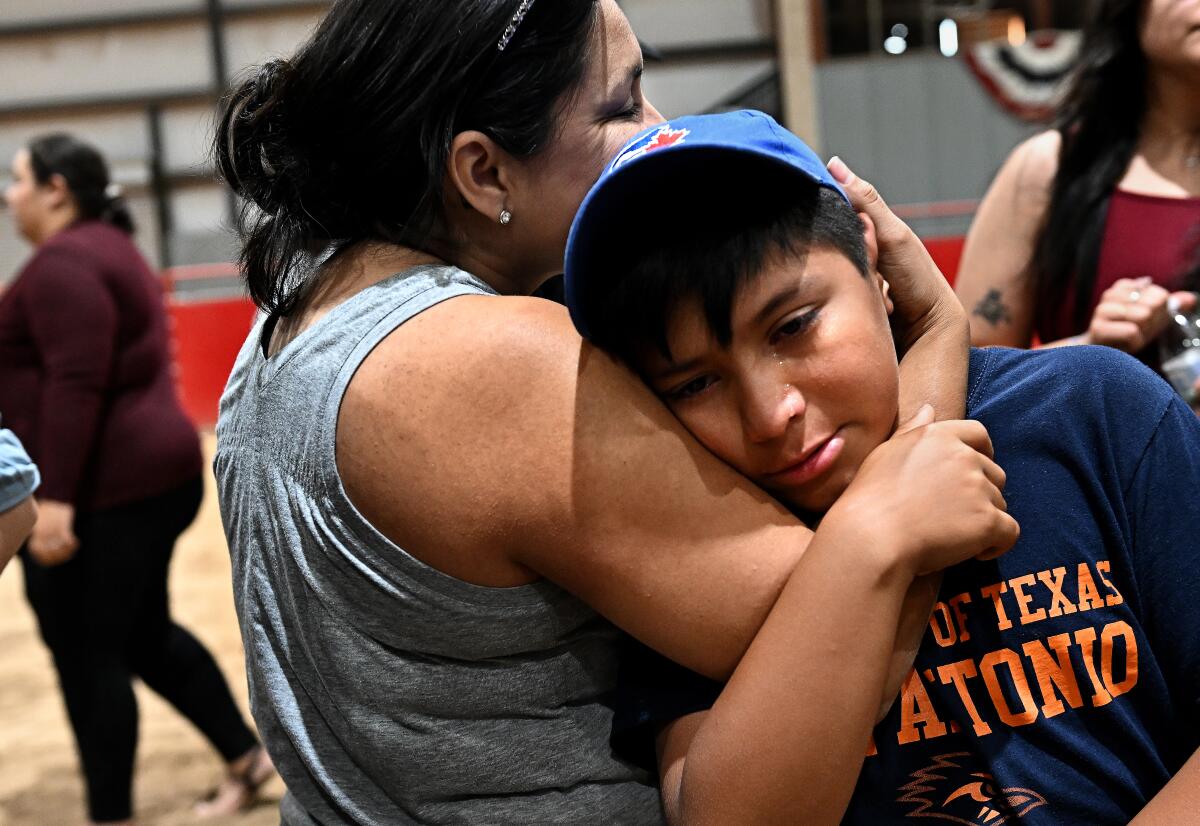Column: A school threat. Do you send your child or keep them home?

- Share via
The call came at 7 a.m., before I had enough coffee in me to process it: A recorded message from the principal of my daughter’s high school, informing us of a credible threat.
There wasn’t too much detail, just that the police had contacted her about a Facebook post that named the school. Classes would go on as usual, with extra security.
Now what? I thought.
We can’t pretend anymore that a kid posting on social media about shooting his peers is a joke or that it couldn’t happen in our child’s school — or anywhere, for that matter.
Do I send her anyway, because a day of lost school is hard to make up? What would I do if I told her to go and something happened?
“I don’t know that other generations have had to ask parents and kids to make these decisions,” Erika Felix said when I told her about my dilemma. She’s a professor of clinical psychology at UC Santa Barbara and studies how families are handling gun violence.
Parents all over are trapped between providing reassurance and normality, she said, and “potentially risking regretting that decision the rest of your life,” though she points out that, statistically, mass shootings remain rare.
Still, Generation Z — the recipients of that parental balancing act as well as holders of the knowledge that statistical odds don’t prevent you from becoming a statistic — is suffering from “this chronic low-level hypervigilance,” Felix said. “It’s kind of automatic to them that they look for the escape route.”
We need to stop thinking of gun violence as a few seconds or minutes of hot metal finding purchase in flesh. I mourn for those who have died, this week and every week. I am selfishly grateful not to be touched by the unbearable sorrow of losing a child, a sibling, a parent, a friend.
But we are all victims of gun violence, every single one of us. It’s more than an epidemic, or a public health crisis. It’s personal, and I’m guessing many of you feel it as much as I do. Why are we centering gun rights over our right not to die, not to bury our children? Even more pervasive, over our right to not be afraid?
In this absolutely messed up reality of politicized death in the United States, we have had 72 incidents of gun violence since Jan. 1, including more than three dozen attacks that qualify as mass shootings, according to the Gun Violence Archive, which tracks this grim toll.
That is not a misprint. More than 5,000 people have died from all types of gun violence this year in the United States, and we haven’t even hit spring.
In the latest Stress in America study by the American Psychological Assn., 73% said mass shootings are a significant source of stress. Women of color in particular cited both mass shootings and gun violence in general as adding stress to their lives. That means lost sleep, an inability to concentrate, depression, anxiety — the documented mental health crisis of living with the undertow of brutality.
Felix compares gun violence to a pebble dropped in still water. We can see the immediate concentric circles of its impact, but the ripples will extend all the way to the shore, harder and harder to see but still there. Even if we escape a gun death, we can’t escape the effects of so much murder and pain on our society, and on ourselves.
We are living in the age of gun trauma, with the fear that we or someone we love will be shot as they sit in math class, pick up a carton of eggs at the grocery store or watch a blockbuster in a theater.
Or maybe the bullet will come from a gun wielded by a domestic partner — usually a man — who conflates love with control and abuse. About 70 women are shot and killed every month by an intimate partner.
Or maybe during a robbery for our phone, or if we say the wrong thing to the wrong person, or because someone hates the color of our skin.
We are afraid because it does happen, because the threat is real. Because there are more guns in America than Americans.
Tuesday was the five-year anniversary of the mass shooting at Marjory Stoneman Douglas High School in Parkland, Fla. Seventeen murdered, seventeen wounded by bullets. Thousands traumatized for life.
Monday, the day before that horrific marker of our indifference to children’s lives, three young people were killed by a gunman at Michigan State University. Five wounded. Thousands traumatized for life.
Last week, I was in Half Moon Bay, where a gunman killed five co-workers and injured another at two mushroom farms where he worked. I spoke with Rocio Avila who had just come from the parking lot of her daughter’s school.
Since the shooting, her eldest has been experiencing severe anxiety that a shooter will come for her — so much so that she needs to know her mom is nearby, there if a bullet-spewing boogeyman arrives. So Avila had been spending her days sitting in her car out front, not sure how else to help her child.
It is a powerlessness many of us feel, made infuriating by a Supreme Court apparently so dismissive of its own intellect (and ours) that its conservative majority believes everything worth deciding was finalized by white men in the era of muskets and slavery — an originalist mentality as self-serving as it is cruel.
In Texas this month, the 5th U.S. Circuit Court of Appeals used that approach by ruling that even those under restraining orders because they are accused of domestic violence have a right to keep their guns.
The decision came in a case in which guns were removed from a man who was involved in five separate shootings during a single month — all during a period when he was not legally allowed to possess guns because of a restraining order.
I asked UC Berkeley constitutional law expert Erwin Chemerinsky if there was any chance of meaningful gun reform with that kind of judicial backdrop.
“I think it depends on what you define as ‘meaningful,’” he responded.
Chemerinsky believes the government will be able to continue to require licenses for weapons and prohibit those convicted of felonies from having them, though even that is facing legal challenges. We may also be able to keep guns out of “sensitive places,” such as airports, schools and courthouses.
Maybe we’ll be able to prohibit “particularly dangerous weapons,” he said. But he’s not convinced that will hold for AR-15s and large-capacity magazines, bans on which are also being litigated.
He said a lot of “gun regulation is going to be struck down,” meaning this may get worse before it gets better.
But I’m not giving up hope, and like so many others, I am not giving up the fight for common-sense gun regulation. As a parent, I don’t have that right.
In Half Moon Bay, I walked across the blood stains of one of the victims before I realized what it was, asking forgiveness from the spirit of a woman I never met. In Sacramento a few days later, I walked down a sidewalk where I covered another mass shooting, more forgotten blood under my feet.
I sent my daughter to school despite the threat, and I feel sick with worry as I write this.
What if?
More to Read
Sign up for Essential California
The most important California stories and recommendations in your inbox every morning.
You may occasionally receive promotional content from the Los Angeles Times.











